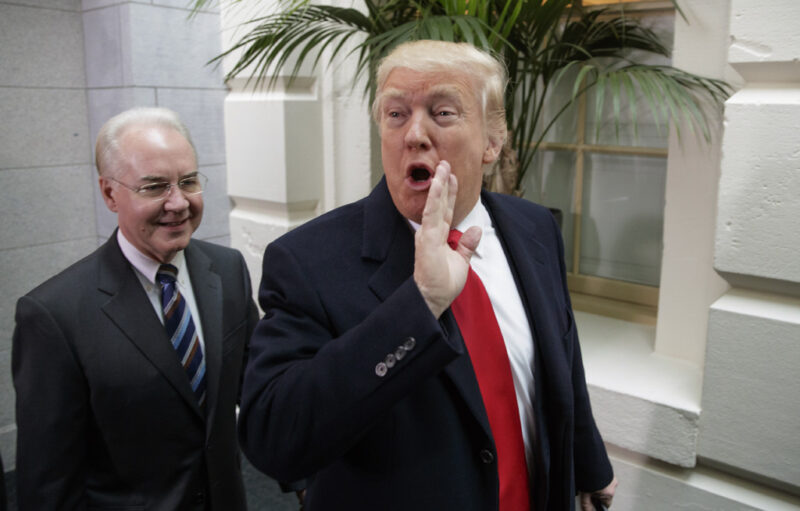The Republican health care bill landed with projections that millions of people would lose their insurance coverage. Among the key questions: Who would be hurt most by the new plan?
AP data journalist Meghan Hoyer, based in Washington, set out to explore the impact of the GOP plan by gathering and analyzing data from several government and private entities. She found that Americans 55 and older who buy private health insurance will pay more than they do under Obamacare — and many of those who'd be hit hardest live in counties nationwide that gave President Donald Trump his strongest support.
Using those findings, reporters Michael Rubinkam in Allentown, Pennsylvania, and Kelli Kennedy in Fort Lauderdale, Florida, searched for people — both Trump backers and Hillary Clinton supporters — to discuss how the plan would affect their finances. The work of these three reporters, blending careful data crunching and compelling shoe-leather reporting, earns the Beat of the Week.

President Donald Trump and Health and Human Services Secretary Tom Price arrive on Capitol Hill, March 21, 2017, to rally support for the Republican health care overhaul.
AP PHOTO / J. SCOTT APPLEWHITE
Government tax credits help lower-income people afford their monthly health insurance premiums. Hoyer's analysis revealed that older residents in counties that favored the president would see reductions in these credits that were 50 percent larger than those in counties with the least Trump support.
The income-related data assembled by Hoyer also gave AP customers specific examples to compare the effects of the Republican plan against former President Barack Obama's Affordable Care Act. She gave the example of a 60-year-old earning either $20,000, $30,000, $40,000 or $50,000 in each state. That data also resulted in a newsworthy conclusion: The less you earn, the more you pay under the GOP plan. This finding was consistent in virtually every state.
In Tennessee, a red state, for example, a 60-year-old earning $50,000 a year would receive $4,990 less from the government each year to help pay for health insurance. But a 60-year-old making just $20,000 would take an even larger hit, with the government providing $9,140 less to help defray the cost of coverage.
Hoyer provided localized numbers for every county in every state. The data sets allowed AP customers to produce localized stories or charts.
Hoyer also provided localized numbers for every county in every state along with information on whether that area had gone for Trump or Clinton. The data sets were sent to AP customers several days before publication, allowing them to produce localized stories or charts.
One of those was the St. Cloud (Minnesota) Times, which used nearly its entire front for a centerpiece package that included the AP story, a locally written sidebar and a county-by-county chart drawn from Hoyer’s data. The detailed information also won plaudits from Mike Colombo, editor of a newspaper in Rome, Georgia, who said: "Fantastic job on the health care data!!! Thank you."
Reporting on real people was the other crucial step. Clinton backers concerned about losing coverage under the GOP plan were eager to speak. Not so much for Republicans who supported Trump.
Rubinkam had to work harder than anticipated to persuade a Trump backer to speak on the record.
Kennedy worked sources for the better part of a week before finding Robert Ruscoe in West Palm Beach, a Republican and Trump supporter who signed up under Obamacare and wants Trump to know that having access to insurance matters. Though Rubinkam lives in a county that voted for Trump, he had to work harder than anticipated to persuade a Trump backer to speak on the record. He reached out to several insurance brokers, contacted hospital networks, a county aging agency, interest groups that usually produce real people for stories and numerous random older Pennsylvania residents who posted recently on Facebook about Obamacare.

Wendy Kline, a hairstylist who voted for Donald Trump poses for a photo in Harrisburg, Pa., March 17, 2017. Kline makes a little too much money to qualify for a government subsidy, so she is stuck paying the market rate. Her monthly health insurance premium costs nearly as much as her mortgage.
AP PHOTO / BRADLEY C. BOWER
He also posted a query on his own Facebook page that was shared 15 times. After several days, those efforts yielded Wendy Kline, a 61-year-old hair stylist whose monthly health insurance premium costs nearly as much as her mortgage.
Reporters Sean Murphy in Oklahoma City and Emery Dalesio in Raleigh, North Carolina, also provided strong, detailed anecdotes of older Americans who would be affected by the Republican health care changes. The four vignettes were equally balanced between Democrats and Republicans.
The story appeared on least 40 front pages and was No. 3 on Mobile for Sunday and in the top 20 for the week. For a time on Sunday, it was the top story on Yahoo News.
For their resourcefulness in producing a story that combined statistical analysis and the human consequences of an issue dominating the news, Hoyer, Rubinkam and Kennedy share this week's $500 prize.
